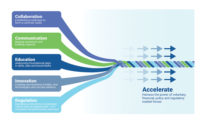As those on the leading edge know, progress in the buildings sector does not come easily. But that doesn’t stop innovators from working diligently to increase the sustainability and resilience of buildings and decrease their carbon footprints while trying to find ways to boost construction quality and building-team productivity.
Many structural engineers dedicated to improving building-design guidance are celebrating this season. A recent challenge to the latest version of the universally recognized reference standard, known as ASCE 7-16, failed after members of the International Code Council voted to include the 2016 update in the 2018 version of the ICC’s model code—the International Building Code.
Supporters of ASCE 7-16 have another reason to be upbeat: The reference standard, set to be published in 2017, includes the world’s first design standard for tsunami resistance.
"In the U.S., tsunami hazard has not been considered at all," says Gary Chock, president of Martin & Chock Inc. and chair of the ASCE’s committee on tsunami loads and effects. "We have filled the gap by providing a means of improving community resilience for critical infrastructure."
Innovators have long had to prove the safety of their brainstorms through testing before building code officials would consider approving cutting-edge designs. In 2016, there were several milestone tests. One group of fire tests demonstrated the viability of using the world’s most sustainable building material—mass timber—for buildings taller than four or five stories. Another series of tests is pushing the needle forward on the use of steel fiber-reinforced concrete (SFRC) to decrease rebar congestion and increase the speed of concrete high-rise construction in seismic zones.
Thanks to the positive fire and structural test results, the framers of what would be the tallest mass-timber building in the U.S.—the 12-story Framework Tower, designed for a site in Portland, Ore.—expect construction permits by March. "The design passed all the major fire tests," says Thomas Robinson, founding principal of LEVER Architecture, which designed the building with structural consultant KPFF Consulting Engineers and fire-protection engineer Arup. "We’re going to get a permit for this project," adds Robinson.
A series of successful tests on SFRC coupling beams—headers that link openings in shear walls—are likely to result in greater structural use of the material. The test results “show a way forward for the development of a performance-based specification for steel fiber, as opposed to a product-based spec,” says Cary Kopczynski, CEO of the structural firm that bears his name and the pioneer in the use of SFRC link beams in four high-rises in the Seattle area. “This will open up the competitive marketplace.”
A full-size, real-world test—construction of the world’s tallest volumetric modular building—is just about finished. After delays and other hardships, the 32-story 461 Dean in Brooklyn, N.Y., is substantially complete. But the opening of the residential tower at the Pacific Park Brooklyn development, formerly known as Atlantic Yards, comes two years late and, if anything, gives tall modular delivery a black eye, thanks to fit-up, production and legal woes. Though Forest City Ratner Cos. is moving ahead with other residential towers in Pacific Park Brooklyn, the developer is using conventional project delivery, not volumetric modular.
Energy Hogs
If U.S. buildings were considered a nation, they would rank third in global energy consumption, after the U.S. and China, according to the Rocky Mountain Institute. In 2015, U.S. residential and commercial buildings used about 40% of the total U.S. energy consumed, or about 39 quadrillion British thermal units, according to the U.S. Energy Information Administration.
Consequently, there are many efforts to cut the carbon footprints of the nation’s buildings. In late 2016, Evanston, Ill.; Portland, Maine; and Pittsburgh enacted building energy-use benchmarking laws, setting at 20 the total number of local U.S. jurisdictions that require some form of annual reporting of building energy use.
Though data is just beginning to trickle in, recent studies indicate that the disclosure policies themselves—somewhat controversial among building owners—may be spurring some energy conservation in public and private buildings.
“A lot of U.S. cities are taking a leadership role, responding to the threats of climate change and making commitments to reduce carbon emissions,” says Zachary Hart, manager of building-performance policy at the Institute for Market Transformation, a nonprofit devoted to cutting building energy consumption. “Energy benchmarking is one piece of the pie,” he adds.
The two-year-old City Energy Project, created to help cities with their benchmarking programs, recently doubled, to 20 municipalities, the number of participants in its power and water conservation program. CEP provides aid and technical assistance to cities for developing voluntary programs and binding policies to reduce building energy consumption.
The group hopes to meet its 2030 goal of reducing annual utility bills of building owners in CEP member cities by more than $1.5 billion while curbing annual building carbon emissions by more than 9.6 metric tons.






Post a comment to this article
Report Abusive Comment